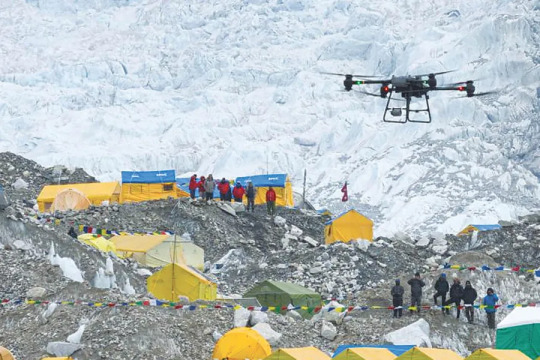#drone laws in Nepal
Explore tagged Tumblr posts
Text
The Best News of Last Year - 2024 Edition
Welcome to our special edition newsletter recapping the best news from the past year. I've picked one highlight from each month to give you a snapshot of 2024. No frills, just straightforward news that mattered. Let's relive the good stuff that made our year shine.
1. January - South Korea passes law banning dog meat trade

The slaughter and sale of dogs for their meat is to become illegal in South Korea after MPs backed a new law. The legislation, set to come into force by 2027, aims to end the centuries-old practice of humans eating dog meat.
2. February - Greece legalises same-sex marriage

Greece has become the first Christian Orthodox-majority country to legalise same-sex marriage. Same-sex couples will now also be legally allowed to adopt children after Thursday's 176-76 vote in parliament. Prime Minister Kyriakos Mitsotakis said the new law would "boldly abolish a serious inequality".
3. March - Global child deaths reach historic low in 2022 – UN report

The number of children who died before their fifth birthday has reached a historic low, dropping to 4.9 million in 2022. The report reveals that more children are surviving today than ever before, with the global under-5 mortality rate declining by 51 per cent since 2000.
4. April - Restoring sight is possible now with optogenetics

Max Hodak's startup, Science, is developing gene therapy solutions to restore vision for individuals with macular degeneration and similar conditions. The Science Eye utilizes optogenetics, injecting opsins into the eye to enhance light sensitivity in retinal cells. Clinical trials and advancements in optogenetics are showing promising results, with the potential to significantly improve vision for those affected by retinal diseases.
5. May - Vaccine breakthrough means no more chasing strains

Scientists at UC Riverside have demonstrated a new, RNA-based vaccine strategy that is effective against any strain of a virus and can be used safely even by babies or the immunocompromised.
6. June - Bill Gates-backed startup creates Lego-like brick that can store air pollution for centuries

The Washington Post detailed a "deceptively simple" procedure by Graphyte to store a ton of CO2 for around $100 a ton, a number long considered a milestone for affordably removing carbon dioxide from the air. Direct air capture technologies used in the United States and Iceland cost $600 to $1,200 per ton, per the Post.
7. July - Stem cell therapy cures man with type 2 diabetes

A 59-year-old man had been suffering from diabetes for 25 years, needing more and more insulin every day to avoid slipping into a diabetic coma and was at risk of death. But then Chinese researchers cured his disease for the first time in the world. The patient received a cell transplant in 2021 and has not taken any medication since 2022.
8. August - Chinese drones will fly trash out of Everest slopes

Come autumn, Nepal will deploy heavy lifter drones to transport garbage from the 6,812-metre tall Ama Dablam, south of Everest. This will be the first commercial work an unmanned aerial vehicle does in Nepal’s high-altitude zone.
9. November - Tokyo to make day care free to boost birth rate

Tokyo plans to make day care free for all preschool children starting in September, the city governor has announced as part of efforts to boost Japan's low birth rate.
10. October - FTC Rule Banning Fake Product Reviews Takes Effect With Stiff Penalties

Federal Trade Commission (FTC) Chair Lina Khan announced on Oct. 21 that the agency’s prohibition on fake online reviews was taking effect, imposing fines as high as $50,000 for violations. Khan encouraged followers to report the proscribed practices at reportfraud.ftc.gov.
11. November - Bumblebee population increases 116 times over in 'remarkable' Scotland rewilding project

The bumblebee population has made an impressive comeback in a developed area by increasing to 116 times what it was two years ago thanks to a nature restoration group.
12. December - Spain to enshrine gay marriage and abortion rights into its constitution so 'they cannot be undone in the future'

The left-wing PSOE leader made the announcement at an event marking the 46th anniversary of the Spanish Magna Carta.
“We believe that these are rights that we must protect in the Constitution so that no one can touch them in the future,” Sanchez said in a statement in parliament on Friday.
----------
That's it for last year :)
This newsletter will always be free. If you liked this post you can support me with a small kofi donation here:
Buy me a coffee ❤️
Also don’t forget to share this post with your friends.
465 notes
·
View notes
Text
A former city councillor and member of the Massachusetts national guard who is wanted in the US on child sexual abuse image charges has fled the country and joined the Russian army fighting in Ukraine.
Wilmer Puello-Mota, 28, former city councillor of Holyoke, Massachusetts, went missing on 7 January, two days before he was scheduled to appear in court in Rhode Island in possession of child sexual abuse images and obstruction of justice charges.
This week, Puello-Mota resurfaced at an enlistment centre in the Russian region of Khanty-Mansiysk in western Siberia, where he was captured on film signing a military contract, seated in a room adorned with photographs of Vladimir Putin and the defence minister, Sergei Shoigu
“An American signed a military contract at the patriots centre in Khanty-Mansiysk,” reads a message accompanying the video published by the region’s official channel on Telegram.
Prior to signing the contract with the Russian military, Puello-Mota appears to have fought as a volunteer alongside Russian troops during Moscow’s capture of the Ukrainian town of Avdiivka in February.
That month, Russian pro-war channels circulated footage of a blurred figure in combat fatigues planting the US flag in the ruins of a Ukrainian city in support of Russia.
“I’m here to plant the US flag as a sign of friendship and support for all the things people are enduring here,” the person in the video said, his face blurred.
“I feel proud to be here.”
The Massachusetts-based newspaper the Republican said that people who know Puello-Mota had recognised his voice in the clip.
Appearing to confirm his participation in the battle for Avdiivka, Puello-Mota in the clip on Wednesday described previously fighting in Ukraine as part of the pro-Russian Pyatnashka international paramilitary group.
“I definitely would do it again,” he is heard saying.
Puello-Mota was first arrested in 2020 after police in Rhode Island discovered sexually explicit images of an underage girl on his phone. According to court documents, he told police that he thought the girl was 22, and only learned later that she was 17.
He was later charged with forgery, counterfeiting and obstruction of the judicial system after he allegedly told one of his commanders at the Massachusetts Air National Guard that the child sexual abuse image charges in Rhode Island were fake.
Puello-Mota is a former member of the 104th Fighter Wing of the Massachusetts Air National Guard, according to the US regional Masslive outlet.
After failing to attend his court hearing, the Rhode Island attorney general’s office issued a statement saying Puello-Mota boarded a Turkish Airlines flight to Istanbul on 7 January.
“His whereabouts from that location are unknown,” the court said at the time.
Puello-Mota did not respond to a request for comment.
His Facebook page now features a picture of Puello-Mota in full military gear operating a drone while he lists his current job as the Russian defence ministry.
Since the start of the war in Ukraine, Russia has introduced a series of laws to lure foreign citizens to join its ranks. Nationals from Cuba, Syria, Nepal and Serbia have all been deployed on the Russian side of the war.
But it is rare for fighters from the EU, UK or the US to join the Russian army. At least two British men are believed to be fighting with Russian forces in Ukraine.
Pro-war bloggers close to the Russian military and state media on Thursday made no mention of Puello-Mota’s fugitive status in the US, instead spinning his defection as a PR coup for Moscow.
“Will served in the US armed forces, but after realising what was really happening in Ukraine, he joined the war as a volunteer a few months ago. Together with the Russian guys, he liberated Avdeevka shoulder to shoulder,” the prominent pro-war blogger Yuri Kotenok wrote on telegram.
Another Russian report said: “[Puello-Mota] is staunchly convinced of the need to support Russia and admires the tenacity and heroism of our soldiers.”
4 notes
·
View notes
Text
Why You Should Hire a Fixer in Nepal for Filming Projects
Nepal, with its majestic Himalayan mountains, serene lakes, and culturally rich cities, attracts filmmakers from around the globe. Yet, filming in Nepal isn’t straightforward; it requires navigating local regulations, securing multiple permits, and having knowledge of logistics. Whether you're a solo documentarian or part of a major production crew, hiring a fixer in Nepal is crucial for a seamless, successful project.
Our expert fixers not only guide you through the necessary steps but ensure a smooth experience by managing every detail—saving you time, reducing costs, and helping you avoid unnecessary hurdles. From acquiring filming permits in Nepal to arranging aerial permits, working with a local fixer is the key to capturing Nepal’s beauty with confidence and ease.
Why Do You Need a Fixer in Nepal?
Filming in a foreign country can pose challenges, especially in Nepal, where government regulations and customs vary significantly across regions. A fixer in Nepal helps bridge these gaps, handling everything from language barriers to location permits and logistics. Here’s why hiring a fixer in Nepal is essential:
Understanding Local Regulations Fixers in Nepal understand the country’s legal landscape, from filming permits to restrictions in protected areas. They’re knowledgeable about the nuances of filming laws, making it easy for you to focus on the creative aspects of your project.
Navigating Cultural and Logistical Challenges In Nepal, respect for cultural and religious practices is paramount. A local fixer ensures your project is aligned with local customs, especially if you're filming in sacred or sensitive areas.
Effective Time and Budget Management Fixers help optimize both time and resources by managing all aspects of logistics, from transportation to accommodations, and even securing special equipment or translators when needed.
The Process of Obtaining Filming Permits in Nepal
Securing filming permits in Nepal is often a multi-step process involving different government bodies, depending on the filming location and subject. Here’s a breakdown of the main permits fixers can assist with:
General Filming Permits Required for any professional filming activity, these permits cover public spaces, including urban areas, rural settings, and some tourist sites. A local fixer in Nepal will handle the application process with the appropriate government offices to obtain permissions on time.
Special Location Permits Nepal is home to UNESCO World Heritage Sites, national parks, and religious monuments, many of which require additional permits. A fixer will liaise with local authorities to acquire these permits, ensuring compliance with location-specific rules.
Aerial Permits in Nepal Drone shots are popular among filmmakers but require specific aerial permits in Nepal due to airspace regulations. Working with a fixer in Nepal guarantees that you meet all necessary guidelines set by the Civil Aviation Authority of Nepal, enabling you to capture stunning aerial footage safely and legally.
What to Expect from a Fixer in Nepal
Fixers provide valuable insights that enhance your production experience, taking care of every detail so you can concentrate on filming. Here’s what our fixers offer:
Permit Applications and Approval The process of acquiring filming and aerial permits in Nepal can be time-consuming and confusing. A fixer navigates this for you, communicating with officials and ensuring applications are submitted correctly to avoid delays.
Scouting and Securing Locations Whether you need a bustling Kathmandu street or a remote village, a fixer will assist in scouting locations that align with your vision, arranging local permissions, and coordinating access to remote or restricted sites.
Local Transportation and Accommodation Arrangements Getting around Nepal can be challenging, especially in rural areas. Fixers will arrange transport and accommodation, helping you stay on schedule and within budget.
Equipment and Crew Support Need specialized equipment? Fixers can source cameras, lighting, and even crew, allowing you to work with trusted local resources, from camera operators to interpreters and support staff.
How Aerial Permits in Nepal Elevate Your Project
Nepal’s landscapes are best appreciated from above, making aerial footage a game-changer. However, using drones or helicopters for filming requires strict adherence to local laws. Here’s why working with a fixer is crucial for aerial filming:
Civil Aviation Compliance Drones and other aerial equipment need approval from the Civil Aviation Authority of Nepal. A fixer ensures that all necessary aerial permits in Nepal are secured, avoiding legal issues and ensuring smooth filming.
Safety and Environmental Regulations Certain areas, especially near wildlife reserves or heritage sites, have additional restrictions. A fixer provides guidance on filming safely and ethically, ensuring your project respects local regulations.
Optimal Timing and Location Insights With their local expertise, fixers advise on the best time and place for aerial shots, considering factors like weather, lighting, and seasonal visibility, to capture the best footage for your project.
Frequently Asked Questions About Hiring a Fixer in Nepal
What Are the Benefits of Hiring a Fixer? A fixer saves you time, handles all local processes, and ensures compliance with Nepalese laws, letting you focus on creating without distraction.
How Long Does It Take to Get Filming Permits? Permit processing time varies depending on location and type, but with a fixer, the timeline is expedited through efficient management and established local contacts.
What Types of Projects Can Fixers Assist With? From documentaries and feature films to commercials and travel videos, a fixer can help any project requiring logistics, permits, and local expertise.
Conclusion:
Work with Our Fixers in Nepal for a Stress-Free Filming Experience
Nepal offers endless possibilities for filmmakers, but navigating its unique regulatory landscape can be overwhelming. By hiring a fixer in Nepal, you gain a knowledgeable partner who handles every detail—from filming permits to aerial permits in Nepal—so that you can focus on bringing your vision to life. Contact us today to learn how our experienced fixers can elevate your project, making your filming journey in Nepal smooth, efficient, and unforgettable.
1 note
·
View note
Text
How to Hire a Fixer in Nepal for a Successful Filming Experience
Nepal, with its breathtaking landscapes and rich cultural heritage, is a premier destination for filmmakers around the world. However, filming here requires local expertise to navigate challenges, acquire permits, and ensure smooth operations. That’s where hiring a fixer in Nepal can be invaluable. Whether you're here to capture the mighty Himalayas or the bustling streets of Kathmandu, a skilled fixer in Nepal can be your key to success.
Why Hire a Fixer in Nepal?
A local fixer not only offers logistical support but also a deep understanding of Nepalese customs and regulations. Hiring a fixer in Nepal means you have someone to streamline the complex process of organizing shoots, obtaining permissions, and managing schedules with efficiency and local insight. Here’s why filmmakers trust our fixers:
Expert Knowledge: Fixers understand local filming regulations and can quickly handle unexpected situations.
Streamlined Process: They take care of permits, from filming to aerial permits, ensuring every step complies with Nepalese law.
Local Network: A trusted fixer brings with them connections within local communities and government bodies, ensuring faster access to locations.
Navigating Filming Permits in Nepal
Securing filming permits in Nepal can be daunting due to the country’s regulations on both ground and aerial footage. Local fixers are experienced in handling these processes, making sure that your project complies with all legal requirements. Here’s an overview of the permits you may need:
Filming Permits: Required for capturing footage in both public and restricted areas.
Aerial Permits: Essential for drone or helicopter shots to ensure safety and adherence to civil aviation rules.
Types of Permits We Can Assist With
General Filming Permits: For urban and rural locations.
Special Location Permits: For heritage sites, religious landmarks, and conservation areas.
Aerial Permits in Nepal: For drone and aerial shots, requiring specific permissions from aviation authorities.
The Importance of Aerial Permits in Nepal
Aerial shots can transform a film, offering sweeping views of Nepal’s landscapes. However, securing aerial permits in Nepal is essential for safety and regulation compliance. Working with a fixer ensures that your aerial permits are obtained correctly and efficiently, leaving you free to focus on your creative vision.
Conclusion: Partner with Us for a Smooth Filming Journey
If you're looking for an experienced fixer in Nepal, contact us today to streamline your filming experience. From arranging filming permits in Nepal and aerial permits to managing on-ground operations, our team is here to support you every step of the way.
1 note
·
View note
Text
Holidays 5.1
Holidays
Agriculture Day (Haiti)
Americanism Day (Pennsylvania)
Amtrak Day
Anxiety Disorders Screening Day
Batman Day
Beer Pong Day [1st Saturday]
Big Brew Day [1st Saturday]
Bladder Cancer Awareness Day [1st Saturday]
Calends of May (Ancient Rome)
Cheerios Day
Childhood Stroke Awareness Day [1st Saturday]
Chimney Sweeps Day
Chocolate Parfait Day
Clun Green Man Festival begins (UK) [Saturday before 1st Monday in May]
Couple Appreciation Day
CSS Reboot Day
Dipping Day
Empire State Building Day
EuroMayDay
Exaltation of Ribeiro Wine (Spain)
Executive Coaching Day
Festa Del Serpari (Procession of the Snake Catchers; Italy)
Festival of the Hare
Fête de l'iris (Brussels Region Day; Belgium) [Begins 1st Saturday]
Floria (Goddess of Flowers; Old Roman)
Free Comic Book Day [1st Saturday]
Frequent Flyer Day
Gambrinus’ Teufelstisch (Midnight Feast at the Devil’s Table; Germany)
Garland Dressing (UK)
Give Local America Day
Global Love Day
Go Fetch! National Food Drive For Animals
Gujarat/Maharashtra Day (India)
Half-O-Ween
Hobby Horse Parade (a.k.a. ‘Obby ‘Oss; Cornwall, UK)
Holland Tulip Time Festival begins (Michigan) [1st Saturday]
Independence Day (Scotland; from England, 1328)
International Dawn Chorus
International Drone Day [1st Saturday]
International Sunflower Guerrilla Gardening Day
International Workers’ Day
Iodized Salt Day
J-Day (Dunedin, Scotland) [1st Saturday, from High Noon until 4:20]
Join Hands Day [1st Saturday]
Kallemooi (The Netherlands)
Keep Kids Alive! Drive 25 Day
Kentucky Derby Day [1st Saturday]
Kevadpuha (Spring Day; Estonia)
Learn to Ride a Bike [1st Saturday]
Lei Day (Hawaii)
Lemonade Day [1st Saturday]
Loyalty Day
Maharashtra Day (Gujarat, Maharashtra; India)
Mariachi Day [1st Saturday]
Marvin Gaye Day (Washington, D.C.)
Mati-Syra-Zemlya Pregnancy Day (Mati-Syra-Zemlya, Slavic Goddess of the Earth)
May Day [1st Day of Summer in Many Traditions] (a.k.a. …
Araw ng Manggagawa (Philippines)
Beltane (Northern Hemisphere)
Calan Mai (Wales)
Dag van de arbeid (Suriname)
Darba Svetki (Latvia)
Den na Trudot (Macedonia)
Día Internacional de los Trabajadores (Cuba)
Dia Mundial do Trabalho (Brazil)
Dita Ndërkombëtare e Punës (Albania, Estonia)
Fiesta del Trabajo (Spain)
Första maj (Sweden)
Jum il-Haddiem (Malta)
Kevadpüha (Estonia)
Labour Day (everywhere but U.S., Canada & Bermuda)
Law Day (US)
Majdoor Divas (Nepal)
Praznik Rada (Croatia, Serbia)
Samhain (Southern Hemisphere)
Staatsfeiertag (Austria)
Vappu (Finland)
Workers’ Day (Ghana)
Mother Goose Day
Moving Day (Colonial New York City)
National Auctioneers Day [1st Saturday]
National Black Barber Shop Appreciation Day
National Bombshells’ Day [1st Saturday]
National Dance Day
National Day to Prevent Teen Pregnancy
National Explosive Ordinance Disposal Day [1st Saturday]
National Fitness Day
National Herb Day [1st Saturday; also Last Saturday in April]
National Homebrew Day [1st Saturday]
National Love Day (Prague, Czech Republic)
National Mantra Day
National Play Outside Day [1st Saturday of Every Month]
National Purebred Dog Day
National Rotate Your Beer Day
National Scrapbooking Day [1st Saturday]
National Show Your Smile Day
National Silver Star Banner Day
National Start Seeing Monarchs Day [1st Saturday]
New Homeowner's Day
’Obby ‘Oss Parade (Padstow, Cornwall, England)
Pack Rag Day
Phone in Sick Day
Pilates Day [1st Saturday]
Plant A Flower Day
Play of Saint Evermaar (Belgium)
Race of the Old Men Day (Ancient Greece)
Repentance Day (Scotland)
Riding of the Bounds (Berwick-upon-Tweed, England)
Rite of Vigyld (Elder Scrolls)
Rodonitsa (Feast to the Ancestors; Asatru/Slavic Pagan)
Santacruzan (Philippine Girls' Festival)
Satyr's Day (Silenus, Greek God of Beer Buddies and Drinking Companions) [1st Saturday of Each Month]
Save the Rhino Day
School Principals’ Day
Silver Star Day
Skyscraper Day
Stepmother’s Day
Swieta Panstwowe (Poland)
Tammany’s Day
Therapeutic Massage Awareness Day
Traditional Fertility Festival
Unity Day (Kazakhstan)
Walpurgis Night (Central & Northern Europe)
Wildlife Community Preparedness Day [1st Saturday]
World Asthma Day
World Naked Gardening Day [1st Saturday]
Worthy Wage Day
Zuni Green Corn Dance
Christian Feast Days
Acheolus
Acius
Amator, Bishop of Auxerre
Andeolus
Asaph, Bishop of Llanewy, in North Wales
Augustin Schoeffler, Jean-Louis Bonnard (part of Vietnamese Martyrs)
Benedict of Szkalka
Brioc (a.k.a. Briocus of Wales)
Efisio
James the Less (Anglican Communion)
Joseph the Worker (Roman Catholic)
Klymentiy Sheptytsky (Ukrainian Greek Catholic Church
Marcouf (a.k.a. Marcon, Abbot of Nanteu, in Normandy))
Peregrine Laziosi
Philip the Apostle (Anglican Communion, Lutheran Church)
Richard Pampuri
Sigismund of Burgundy
Tamenend
Ultan
0 notes
Text
Drones and the future of conservation
Around the world, conservationists are using drones to protect endangered species and battle wildlife crime
The drone wars have begun and battle lines are drawn. Privacy stands on one side and possibilities on the other. It hardly seems like a fair fight. The possibilities are endless, as we’re learning day by day, and the best privacy can do is reach a compromise.
Drones are quickly swooping into the commercial sector, from helping property owners sell homes to delivering pizza. Amazon caused a buzz on 60 minutes with their demo of Amazon Prime Air, an urban delivery system capable of dropping packages right to your doorstep in half an hour. The Octocopter drone is far from urban reality, but Jeff Bezos, founder and CEO of Amazon, believes it’s only a matter of time.
Last month, the US Federal Aviation Administration (FAA) announced six test sites for commercial drone use. Over the next few months the FAA hopes to draft rules and regulations needed to safely use drones and protect people’s privacy. Meanwhile, there are some states that have already banned private and law-enforcement drone use.
But drones are riding a global wave, and it’s only getting bigger. We’re coming to understand that drones aren’t just tools of destruction, as portrayed by the military, but simply tools. Their utility is only limited by the human imagination.
For instance, have you heard of drones being used to combat crimes against wildlife in Nepal? Or plan orangutan rescue operations in Indonesia? Or use thermal imaging cameras to identify poachers in Kenya?
Just like the commercial sector, conservationists are discovering the possibilities with drones and are using them to preserve nature and protect wildlife.
Drones and conservation
Drones and conservation are a fresh match. Until recently, drones had been too expensive for NGOs and researchers to afford. Besides, someone had to take the leap to show others the way.
Conservation Drones was started by professors Lian Pin Koh and Serge Wich. Their research interests in conservation and mammals brought them together in 2011. Their imagination and boyish curiosity is what led to Conservation Drones.
Koh and Wich realized that commercial drones were not an option for the average research budget. Drones needed to be cheaper, with the type of accessories that benefited researchers, like high definition cameras.
After a successful demo flight in North Sumatra, Indonesia, Koh and Wich were overwhelmed by the response from fellow researchers. Since then, Conservation Drones have taken flight all over the world. There are other organizations like Research Drones, and individuals who are stepping up to use drones for conservation in all kinds of creative ways.
In Nepal, drones are being used by the WWF and the Nepal army to protect the greater one-horned rhinoceros from poachers. In Belize, the fisheries department and Wildlife Conservation Society are considering using drones to monitor illegal fishing activities off the coast. In Kenya, drones – and chilli powder – are being used to scare away elephants from areas with known poaching activity.
In Indonesia, the Sumatran Orangutan Conservation Programme (SOCP) is using drones in ways that would make a CIA operative’s job sound mundane.
The rainforests of Sumatra is a species rich ecosystem and is home to many critically endangered animals, including tigers, rhinos, elephants and orangutans. Parts of the forest are covered by peat swamp, which are carbon rich storage vaults. Globally, peatlands store as much as 500 billion metric tons of carbon, twice as much as trees all around the world. Yet they only cover three per cent of the globe.
But the rainforest and wildlife are under threat from logging (legal and illegal), poaching and forest fires. Palm oil plantations are a big source of income for the Sumatran economy. Palm trees are cheap and easy to grow in temperate climate, and palm oil is ubiquitous in all household products, from soap to sweets. To make room for more plantations, the natural forest and its inhabitants are sacrificed. The government, farm owners and environmentalists have been battling each other over the rights and responsibilities for the ecosystem for years.
It was in North Sumatra where Koh and Wich first tested their prototype drone. And it’s here where we find Graham Usher, a Landscape Protection Specialist with the SOCP, and drone specialist. Usher is using drones to save orangutans, fight crime and preserve the carbon rich peat swamp.
Fighting Crime and Saving Orangutans
Graham flies drones over the forest to spot illegal hunting and logging camps, which are fairly common in North Sumatra. “It is often possible to spot tarpaulins of logging/hunting camps, which allows pin pointing of problems for ground level action,” says Usher. “Isolated blue tarpaulins in the forest can only be four things: illegal logging, illegal hunters, researchers/survey teams, or possibly illegal miners. We usually know if there are researchers or survey teams around.”
Illegal activities spotted by drones are reported to Indonesian law enforcement authorities. In this manner, drones are helping conservation in more than one way. The local authorities don’t have the resources to monitor the forest like Graham and his team do.
Drone surveillance is also used to find fragmented areas of the forest where animals, like orangutans, may be trapped and in need of rescuing. Orangutans typically stay in the safety of tree canopies, rarely stepping down onto the forest floor. Large swaths of land cleared for logging and plantations can leave them trapped in an area, isolated from food and companions.
Low flights with high resolution cameras make it possible to identify individual trees and orangutan nests separated from other parts of the forest.
It also helps keep track of orangutan numbers and preservation efforts. Traditionally, this kind of bookkeeping would require sending a survey team by foot to count orangutan nests. This method is labour intensive, time consuming and potentially dangerous, especially in swampy areas.
Without drones, Graham and his team would have to rely on satellite imagery. While these are free, the images are usually unclear and don’t have the resolution needed for the type of work SOCP is doing. There is also a delay from when the images are taken, processed, and available to the public. Drones provide almost real-time surveillance, which is necessary to catch illegal loggers and poachers. It also makes it possible to organize rescue operations for orangutans that have been isolated by fire or deforestation. Waiting for satellite imagery to come through could mean life or death for an orangutan.
youtube
1 note
·
View note
Text
June 29, 2020 National and World News
from nytimes
Supreme Court Strikes Down Louisiana Abortion Restrictions. The vote was 5 to 4, with Chief Justice John G. Roberts Jr. voting with the court’s four-member liberal wing ** but not adopting its reasoning. The chief justice said respect for precedent compelled him to vote with the majority. The case was the court’s first on abortion since President Trump’s appointments of two justices shifted the court to the right. The Louisiana law, which was enacted in 2014, requires doctors performing abortions to have admitting privileges at nearby hospitals. (Abortion providers are often unable to obtain admitting privileges for reasons unrelated to their competence.) Only two of the five doctors who provide abortions in Louisiana have obtained admitting privileges, one in New Orleans and one in Shreveport. But the Shreveport doctor testified that he could not handle the clinic’s work alone. If the law went into effect, a trial judge concluded, there would be a single doctor in a single clinic, in New Orleans, available to provide abortions in Louisiana. A judge, John W. deGravelles of the Federal District Court in Baton Rouge, struck down the Louisiana law in 2017, saying it created an undue burden on women’s constitutional right to abortion. The experience of the clinic in Shreveport, Hope Medical Group for Women, showed, he wrote, that the law was a solution in search of a problem. “In the last 23 years, Hope Clinic, which serves in excess of 3,000 patients per year, had only four patients who required transfer to a hospital for treatment,” Judge deGravelles wrote. “In each instance, regardless of whether the physician had admitting privileges, the patient received appropriate care.” The law, Judge deGravelles ruled, was essentially identical to the one from Texas that the Supreme Court struck down in the 2016 decision, Whole Woman’s Health v. Hellerstedt. Justice Stephen G. Breyer, writing for the majority in that decision, said courts must consider whether the benefits claimed for laws that put restrictions on abortion outweigh the burdens they put on the constitutional right to the procedure. There was no evidence that the Texas law’s admitting-privileges requirement “would have helped even one woman obtain better treatment,” Justice Breyer wrote. But there was good evidence, he added, that the requirement caused the number of abortion clinics in Texas to drop to 20 from 40. The vote in that decision was 5 to 3, with Justice Anthony M. Kennedy joining the court’s four-member liberal wing to form a majority.
** from cnn.com, the "liberal wing" is Breyer, Ginsburg, Kagan, and Sotomayor
Despairing of finding enough beds for patients stricken with the coronavirus, a nurse (Valentina M. Monkhoroeva) in the Siberian city of Irkutsk has been forced to begin taking people to a village hospital more than 100 miles away. As Ms. Monkhoroeva’s predicament illustrates, the pandemic is now advancing, not receding, across much of Russia’s vast hinterland. But that has not dimmed the Kremlin’s determination to hold a nationwide vote on constitutional amendments that, among other things, would enable President Vladimir V. Putin to stay in power until 2036. The Irkutsk regional Parliament, whose members include a large group of noisy Communists, has been forthright in its skepticism about the wisdom of declaring the coronavirus crisis over and about whether the situation is safe enough to hold a vote. The number of new infections is indeed falling in Russia, but that is the result mostly of a steep decline in new infections in Moscow, the initial epicenter of the pandemic in the country. The situation in Irkutsk and other far-flung places looks very different.
India’s Capital Faces a ‘Swarmageddon’ of Locusts. The country is weathering its worst invasion in more than two decades. With the monsoon season looming, scientists worry that the worst is yet to come. Insects have moved from western regions to the New Delhi area and farther east to Nepal despite efforts to douse crops with pesticides and kill swarms using drones. More than a half-dozen Indian states have been affected.
Broadway Will Remain Closed Through the Rest of the Year. The industry said it would refund tickets through Jan. 3, and hopes that shows would be able to reopen “over a series of rolling dates in early 2021.”
0 notes
Text
Eyes in the sky: Heat-seeking drones used after tornado
Rescue crews didn’t have to stumble through every destroyed building in their search for victims after a tornado ravaged a corner of Alabama this week: They used heat-seeking drones to let them know whether there was anyone beneath the ruins.
In so doing, they joined the increasing ranks of public safety agencies across the U.S. and around the world that have employed unmanned thermal-imaging aircraft during critical situations, including manhunts, wildfires and other natural disasters.
In tornado-stricken Alabama, Lee County Sheriff Jay Jones said Tuesday it was not clear if drones spotted any bodies or anyone injured or trapped in the debris. But at the least, they helped reassure searchers that they hadn’t overlooked anyone in the aftermath of the twister that killed 23 people.
“They gave us an overhead view of areas we might have missed had we been at eye level on land,” Jones said.
Thermal-imaging drones use infrared cameras that find heat sources on the ground, in buildings or in water, at any time of day, whether from a human or animal, alive or newly deceased, or from other things, such as flames.
The devices can transmit a color-coded image in real time to a laptop, cellphone, tablet or large-screen monitor. Depending on the settings the user chooses, heat sources can be made to stand out in bright red, white or other colors.
Law enforcement officers and firefighters who use such airborne technology swear by it as a tool to protect and save lives. Drones are cheaper than manned aircraft such as helicopters, which can’t get into tight spaces and require more training.
Officials in China, Nepal and Mexico used drones — with and without heat-detecting equipment — after devastating earthquakes. Firefighters battling fast-moving blazes in California’s woods employed heat-seeking drones to map fires and search burned homes. They also have been used to locate missing people, as in the case of an 11-year-old girl found last year in the thick woods of North Carolina.
In Hamilton County, Tennessee, Sheriff’s Detective Marty Dunn got an urgent call last summer. A man involved in a domestic dispute had fled his home and ventured into the swampy woods near Chattanooga, perhaps with the intention of harming himself.
Dunn rushed to the scene with a thermal-imaging drone. He guided the aircraft over the thick canopy of trees and found what he had been looking for in about 6 minutes — a heat signature that told him a human was sitting at the base of a tree. The man was rescued quickly and safely, Dunn said.
It took less time than a search by deputies and police dogs would have, he said.
“It’s an amazing tool,” Dunn said. “It worked out for the best.”
In the San Francisco area, the Menlo Park Fire Protection District boasts a fleet of about 15 drones with varying capabilities, some with regular cameras, some with thermal-imaging ones. During last year’s devastating wildfires in Northern California, thermal-imaging drones mapped areas where fires raged. The pictures were sent to firefighters’ cellphones, helping them attack the flames efficiently, Chief Harold Schapelhouman said.
Menlo Park firefighters also used thermal drones to find people lost in San Francisco Bay, and took drones to Texas to help after Hurricane Harvey. There, the aircraft scoped out flooded areas to make rescue-boat navigation easier amid fallen trees, power lines and other obstacles, Schapelhouman said.
“It’s a super-efficient piece of equipment,” said Schapelhouman, who estimates the department has spent $200,000 on its drone program, including pilot training.
In Polk County, Florida, Sheriff Grady Judd has a team of 20 drone pilots on his Aerial Response Team. Polk County uses its thermal-imaging drones at night, finding burglars who thought they were safe hiding in the dark.
Drone operations in Florida are limited by strict laws. Judd said the sheriff’s office can use drones only in an emergency, such as a tornado or hurricane, or with a court order.
“We can’t put it in the air just to look at traffic flows or to write traffic citations or anything like that,” Judd said. “You can’t launch them to do even population surveillance at a football game to see where you’re having trouble.”
A Portland, Oregon-based company, FLIR Systems, designs, makes and sells thermal-imaging cameras used by police and fire departments. It has been working on airborne thermal-imaging technology for about 40 years and jumped into the drone camera business for public safety agencies about four years ago, said Jeff Frank, senior vice president for global product strategy.
Camera-and-drone combinations can range from about $1,500 to around $10,000, Frank said.
In a study issued last May, the Center for the Study of Drones at Bard College reported at least 910 state and local police, sheriff, fire and emergency-service agencies in the U.S. have acquired drones.
The report’s author, Dan Gettinger, said it is not clear how many agencies have drones with thermal-imaging capabilities but estimated it is less than 25 percent and increasing.
from FOX 4 Kansas City WDAF-TV | News, Weather, Sports https://fox4kc.com/2019/03/06/eyes-in-the-sky-heat-seeking-drones-used-after-tornado/
from Kansas City Happenings https://kansascityhappenings.wordpress.com/2019/03/07/eyes-in-the-sky-heat-seeking-drones-used-after-tornado/
0 notes
Text
Eyes in the sky: Heat-seeking drones used after tornado
Rescue crews didn’t have to stumble through every destroyed building in their search for victims after a tornado ravaged a corner of Alabama this week: They used heat-seeking drones to let them know whether there was anyone beneath the ruins.
In so doing, they joined the increasing ranks of public safety agencies across the U.S. and around the world that have employed unmanned thermal-imaging aircraft during critical situations, including manhunts, wildfires and other natural disasters.
In tornado-stricken Alabama, Lee County Sheriff Jay Jones said Tuesday it was not clear if drones spotted any bodies or anyone injured or trapped in the debris. But at the least, they helped reassure searchers that they hadn’t overlooked anyone in the aftermath of the twister that killed 23 people.
“They gave us an overhead view of areas we might have missed had we been at eye level on land,” Jones said.
Thermal-imaging drones use infrared cameras that find heat sources on the ground, in buildings or in water, at any time of day, whether from a human or animal, alive or newly deceased, or from other things, such as flames.
The devices can transmit a colour-coded image in real time to a laptop, cellphone, tablet or large-screen monitor. Depending on the settings the user chooses, heat sources can be made to stand out in bright red, white or other colours.
Law enforcement officers and firefighters who use such airborne technology swear by it as a tool to protect and save lives. Drones are cheaper than manned aircraft such as helicopters, which can’t get into tight spaces and require more training.
Officials in China, Nepal and Mexico used drones — with and without heat-detecting equipment — after devastating earthquakes. Firefighters battling fast-moving blazes in California’s woods employed heat-seeking drones to map fires and search burned homes. They also have been used to locate missing people, as in the case of an 11-year-old girl found last year in the thick woods of North Carolina.
In Hamilton County, Tennessee, Sheriff’s Detective Marty Dunn got an urgent call last summer. A man involved in a domestic dispute had fled his home and ventured into the swampy woods near Chattanooga, perhaps with the intention of harming himself.
Dunn rushed to the scene with a thermal-imaging drone. He guided the aircraft over the thick canopy of trees and found what he had been looking for in about 6 minutes — a heat signature that told him a human was sitting at the base of a tree. The man was rescued quickly and safely, Dunn said.
It took less time than a search by deputies and police dogs would have, he said.
“It’s an amazing tool,” Dunn said. “It worked out for the best.”
In the San Francisco area, the Menlo Park Fire Protection District boasts a fleet of about 15 drones with varying capabilities, some with regular cameras, some with thermal-imaging ones. During last year’s devastating wildfires in Northern California, thermal-imaging drones mapped areas where fires raged. The pictures were sent to firefighters’ cellphones, helping them attack the flames efficiently, Chief Harold Schapelhouman said.
Menlo Park firefighters also used thermal drones to find people lost in San Francisco Bay, and took drones to Texas to help after Hurricane Harvey. There, the aircraft scoped out flooded areas to make rescue-boat navigation easier amid fallen trees, power lines and other obstacles, Schapelhouman said.
“It’s a super-efficient piece of equipment,” said Schapelhouman, who estimates the department has spent $200,000 on its drone program, including pilot training.
In Polk County, Florida, Sheriff Grady Judd has a team of 20 drone pilots on his Aerial Response Team. Polk County uses its thermal-imaging drones at night, finding burglars who thought they were safe hiding in the dark.
Drone operations in Florida are limited by strict laws. Judd said the sheriff’s office can use drones only in an emergency, such as a tornado or hurricane, or with a court order.
“We can’t put it in the air just to look at traffic flows or to write traffic citations or anything like that,” Judd said. “You can’t launch them to do even population surveillance at a football game to see where you’re having trouble.”
A Portland, Oregon-based company, FLIR Systems, designs, makes and sells thermal-imaging cameras used by police and fire departments. It has been working on airborne thermal-imaging technology for about 40 years and jumped into the drone camera business for public safety agencies about four years ago, said Jeff Frank, senior vice-president for global product strategy.
Camera-and-drone combinations can range from about $1,500 to around $10,000, Frank said.
In a study issued last May, the Center for the Study of Drones at Bard College reported at least 910 state and local police, sheriff, fire and emergency-service agencies in the U.S. have acquired drones.
The report’s author, Dan Gettinger, said it is not clear how many agencies have drones with thermal-imaging capabilities but estimated it is less than 25 per cent and increasing.
——
Associated Press reporter Kim Chandler contributed to this report from Lee County, Alabama.
from Financial Post https://ift.tt/2EGoNDL via IFTTT Blogger Mortgage Tumblr Mortgage Evernote Mortgage Wordpress Mortgage href="https://www.diigo.com/user/gelsi11">Diigo Mortgage
0 notes
Text
Headlines
Russian Military Says Will Respond if U.S. Strikes Syria: RIA (Reuters) The Russian military will respond to a U.S. strike on Syria, targeting any missiles and launchers involved in such an attack, the RIA news agency reported on Tuesday.
U.S. Transfers Six Surveillance Drones to Philippines (Reuters) The United States handed over six surveillance drones to its ally the Philippines on Tuesday, as part of efforts to boost its ability to tackle a growing threat from Islamist militants and to respond to natural disasters.
EU Assures Britain of Solidarity on Nerve Agent Case (Reuters) The European Union will stand by Britain after London said it was likely that Moscow was behind a nerve toxin attack on a former Russian double agent in England, a senior EU official said on Tuesday.
Turkish Military Says Has Encircled Syria’s Afrin Town (Reuters) Turkey’s military and its rebel allies have encircled the northern Syrian town of Afrin, the Turkish armed forces said on Tuesday, marking as substantial advance in Turkey’s offensive against Kurdish fighters across its southern border.
U.N. Official in Syria Expects an Evacuation of Ghouta Civilians on Tuesday (Reuters) The U.N.’s top aid official in Syria said an evacuation of civilians was expected on Tuesday out of the eastern Ghouta rebel enclave, where the military has waged a fierce offensive.
Australia to Stress International Law in South China Sea Dispute (Reuters) Australian Foreign Minister Julie Bishop will on Tuesday hail the role of international law in settling regional conflicts, comments apparently aimed at bolstering Australian efforts to build a coalition against Chinese assertiveness.
With Immigration on His Mind, Trump Heads to California (Reuters) President Donald Trump will bring a tough message on illegal immigration to California on Tuesday, taking aim at “sanctuary cities” in his first visit in office to the heavily Democratic state that has served as a base of resistance to many of his policies.
Nepal Begins Probe of Plane Crash That Killed 49, Airline Defends Pilot (Reuters) Investigators have retrieved the flight data recorder from the wreckage of a Bangladeshi airliner that crashed, killing at least 49 aboard, including the crew, when it attempted to land in Nepal’s capital, officials said on Tuesday.
China to Improve Veterans’ Care After Protests With New Ministry (Reuters) China will set up a Ministry of Veterans Affairs as part of a government reshuffle presented to parliament on Tuesday, aiming to better look after former soldiers whose complaints about poor treatment have flared into scattered protests in recent years.
Take Refugees or Face Visa Caps, EU to Tell Other Countries: Die Welt (Reuters) The European Commission is planning legislation that would use the threat of denied visas to encourage countries outside the bloc to cooperate on repatriating failed asylum seekers, the German newspaper Die Welt reported on Tuesday.
Mexico Arrests Suspect in 2014 Case of 43 Missing Students (AP) Mexican prosecutors say they have arrested a man who allegedly played a decisive role in the disappearance of 43 college students in 2014.
US Scientists Rescued in Antarctica by Argentina Icebreaker (AP) A group of American scientists who were stranded in an ice-bound island off the northeastern tip of the Antarctic Peninsula were rescued Sunday by an Argentine icebreaker, U.S. and Argentine authorities said Monday.
0 notes
Text
Events 12.23
484 – The Arian Vandal Kingdom ceases its persecution of Nicene Christianity. 558 – Chlothar I is crowned King of the Franks. 583 – Maya queen Yohl Ik'nal is crowned ruler of Palenque. 962 – The Sack of Aleppo as part of the Arab–Byzantine wars: Under the future Emperor Nicephorus Phocas, Byzantine troops storm the city of Aleppo. 1572 – Theologian Johann Sylvan is executed in Heidelberg for his heretical Antitrinitarian beliefs. 1598 – Arauco War: Governor of Chile Martín García Óñez de Loyola is killed in the Battle of Curalaba by Mapuches led by Pelantaru. 1688 – As part of the Glorious Revolution, King James II of England flees from England to Paris, France after being deposed in favor of his nephew, William of Orange and his daughter Mary. 1783 – George Washington resigns as commander-in-chief of the Continental Army at the Maryland State House in Annapolis, Maryland. 1793 – The Battle of Savenay: A decisive defeat of the royalist counter-revolutionaries in War in the Vendée during the French Revolution. 1815 – The novel Emma by Jane Austen is first published. 1876 – First day of the Constantinople Conference which resulted in agreement for political reforms in the Balkans. 1893 – The opera Hansel and Gretel by Engelbert Humperdinck is first performed. 1913 – The Federal Reserve Act is signed into law by President Woodrow Wilson, creating the Federal Reserve System. 1914 – World War I: Australian and New Zealand troops arrive in Cairo, Egypt. 1916 – World War I: Battle of Magdhaba: Allied forces defeat Turkish forces in the Sinai Peninsula. 1919 – Sex Disqualification (Removal) Act 1919 becomes law in the United Kingdom. 1936 – Colombia becomes a signatory to the Buenos Aires copyright treaty. 1936 – Spanish Civil War: The Spanish Republic legalizes the Regional Defence Council of Aragon. 1941 – World War II: After 15 days of fighting, the Imperial Japanese Army occupies Wake Island. 1947 – The transistor is first demonstrated at Bell Laboratories. 1948 – Seven Japanese military and political leaders convicted of war crimes by the International Military Tribunal for the Far East are executed by Allied occupation authorities at Sugamo Prison in Tokyo, Japan. 1954 – First successful kidney transplant is performed by J. Hartwell Harrison and Joseph Murray. 1968 – The 82 sailors from the USS Pueblo are released after eleven months of internment in North Korea. 1970 – The North Tower of the World Trade Center in Manhattan, New York, New York is topped out at 1,368 feet (417 m), making it the tallest building in the world. 1970 – The Democratic Republic of the Congo officially becomes a one-party state. 1972 – A 6.5 magnitude earthquake strikes the Nicaraguan capital of Managua killing more than 10,000. 1972 – The 16 survivors of the Andes flight disaster are rescued after 73 days, surviving by cannibalism. 1979 – Soviet–Afghan War: Soviet Union forces occupy Kabul, the Afghan capital. 1984 – After experiencing an engine fire, Aeroflot Flight 3519 attempts to make an emergency landing at Krasnoyarsk International Airport but crashes, killing 110 of the 111 people on board. 1986 – Voyager, piloted by Dick Rutan and Jeana Yeager, lands at Edwards Air Force Base in California becoming the first aircraft to fly non-stop around the world without aerial or ground refueling. 1990 – History of Slovenia: In a referendum, 88.5% of Slovenia's overall electorate vote for independence from Yugoslavia. 2002 – A U.S. MQ-1 Predator is shot down by an Iraqi MiG-25 in the first combat engagement between a drone and conventional aircraft. 2003 – PetroChina Chuandongbei natural gas field explosion, Guoqiao, Kai County, Chongqing, China, killing at least 234. 2007 – An agreement is made for the Kingdom of Nepal to be abolished and the country to become a federal republic with the Prime Minister becoming head of state. 2015 – A bomb explodes at Istanbul's Sabiha Gökçen Airport, killing one airport cleaner. The Kurdistan Freedom Hawks claim responsibility for the attack four days later.
0 notes
Text
Events 12.23
484 – The Arian Vandal Kingdom ceases its persecution of Nicene Christianity. 558 – Chlothar I is crowned King of the Franks. 583 – Maya queen Yohl Ik'nal is crowned ruler of Palenque. 962 – Arab–Byzantine wars: Under the future Emperor Nicephorus Phocas, Byzantine troops storm the city of Aleppo. 1572 – Theologian Johann Sylvan is executed in Heidelberg for his heretical Antitrinitarian beliefs. 1598 – Arauco War: Governor of Chile Martín García Óñez de Loyola is killed in the Battle of Curalaba by Mapuches led by Pelantaru. 1688 – As part of the Glorious Revolution, King James II of England flees from England to Paris, France after being deposed in favor of his nephew, William of Orange and his daughter Mary. 1783 – George Washington resigns as commander-in-chief of the Continental Army at the Maryland State House in Annapolis, Maryland. 1793 – The Battle of Savenay: A decisive defeat of the royalist counter-revolutionaries in War in the Vendée during the French Revolution. 1815 – The novel Emma by Jane Austen is first published. 1876 – First day of the Constantinople Conference which resulted in agreement for political reforms in the Balkans. 1893 – The opera Hansel and Gretel by Engelbert Humperdinck is first performed. 1913 – The Federal Reserve Act is signed into law by President Woodrow Wilson, creating the Federal Reserve System. 1914 – World War I: Australian and New Zealand troops arrive in Cairo, Egypt. 1916 – World War I: Battle of Magdhaba: Allied forces defeat Turkish forces in the Sinai Peninsula. 1919 – Sex Disqualification (Removal) Act 1919 becomes law in the United Kingdom. 1936 – Colombia becomes a signatory to the Buenos Aires copyright treaty. 1941 – World War II: After 15 days of fighting, the Imperial Japanese Army occupies Wake Island. 1947 – The transistor is first demonstrated at Bell Laboratories. 1948 – Seven Japanese military and political leaders convicted of war crimes by the International Military Tribunal for the Far East are executed by Allied occupation authorities at Sugamo Prison in Tokyo, Japan. 1954 – First successful kidney transplant is performed by J. Hartwell Harrison and Joseph Murray. 1968 – The 82 sailors from the USS Pueblo are released after eleven months of internment in North Korea. 1970 – The North Tower of the World Trade Center in Manhattan, New York, New York is topped out at 1,368 feet (417 m), making it the tallest building in the world. 1970 – The Democratic Republic of the Congo officially becomes a one-party state. 1972 – A 6.5 magnitude earthquake strikes the Nicaraguan capital of Managua killing more than 10,000. 1972 – The 16 survivors of the Andes flight disaster are rescued after 73 days, surviving by cannibalism. 1979 – Soviet–Afghan War: Soviet Union forces occupy Kabul, the Afghan capital. 1984 – After experiencing an engine fire, Aeroflot Flight 3519 attempts to make an emergency landing at Krasnoyarsk International Airport but crashes, killing 110 of the 111 people on board. 1986 – Voyager, piloted by Dick Rutan and Jeana Yeager, lands at Edwards Air Force Base in California becoming the first aircraft to fly non-stop around the world without aerial or ground refueling. 1990 – History of Slovenia: In a referendum, 88.5% of Slovenia's overall electorate vote for independence from Yugoslavia. 2002 – A U.S. MQ-1 Predator is shot down by an Iraqi MiG-25 in the first combat engagement between a drone and conventional aircraft. 2003 – PetroChina Chuandongbei natural gas field explosion, Guoqiao, Kai County, Chongqing, China, killing at least 234. 2007 – An agreement is made for the Kingdom of Nepal to be abolished and the country to become a federal republic with the Prime Minister becoming head of state. 2015 – A bomb explodes at Istanbul's Sabiha Gökçen Airport, killing one airport cleaner. The Kurdistan Freedom Hawks claim responsibility for the attack four days later.
0 notes
Text
Events 12.23
484 – Huneric dies and is succeeded by his nephew Gunthamund, who becomes king of the Vandals. During his reign Christians are protected from persecution. 558 – Chlothar I is crowned King of the Franks. 562 – Hagia Sophia in Constantinople reopened with a rebuilt dome after a series of earthquakes caused the original to collapse. 583 – Maya queen Yohl Ik'nal is crowned ruler of Palenque. 679 – King Dagobert II is murdered while hunting. 962 – Arab–Byzantine wars: Under the future Emperor Nicephorus Phocas, Byzantine troops storm the city of Aleppo. 1572 – Theologian Johann Sylvan is executed in Heidelberg for his heretical Antitrinitarian beliefs. 1688 – As part of the Glorious Revolution, King James II of England flees from England to Paris, France after being deposed in favor of his nephew, William of Orange and his daughter Mary. 1783 – George Washington resigns as commander-in-chief of the Continental Army at the Maryland State House in Annapolis, Maryland. 1793 – The Battle of Savenay: A decisive defeat of the royalist counter-revolutionaries in War in the Vendée during the French Revolution. 1815 – The novel Emma by Jane Austen is first published. 1876 – First day of the Constantinople Conference which resulted in agreement for political reforms in the Balkans. 1893 – The opera Hansel and Gretel by Engelbert Humperdinck is first performed. 1913 – The Federal Reserve Act is signed into law by President Woodrow Wilson, creating the Federal Reserve System. 1914 – World War I: Australian and New Zealand troops arrive in Cairo, Egypt. 1916 – World War I: Battle of Magdhaba: Allied forces defeat Turkish forces in the Sinai Peninsula. 1919 – Sex Disqualification (Removal) Act 1919 becomes law in the United Kingdom. 1936 – Colombia becomes a signatory to the Buenos Aires copyright treaty. 1941 – World War II: After 15 days of fighting, the Imperial Japanese Army occupies Wake Island. 1947 – The transistor is first demonstrated at Bell Laboratories. 1948 – Seven Japanese military and political leaders convicted of war crimes by the International Military Tribunal for the Far East are executed by Allied occupation authorities at Sugamo Prison in Tokyo, Japan. 1954 – First successful kidney transplant is performed by J. Hartwell Harrison and Joseph Murray. 1968 – The 82 sailors from the USS Pueblo are released after eleven months of internment in North Korea. 1970 – The North Tower of the World Trade Center in Manhattan, New York, New York is topped out at 1,368 feet (417 m), making it the tallest building in the world. 1970 – The Democratic Republic of the Congo officially becomes a one-party state. 1972 – A 6.5 magnitude earthquake strikes the Nicaraguan capital of Managua killing more than 10,000. 1972 – The 16 survivors of the Andes flight disaster are rescued after 73 days, having reportedly survived by cannibalism. 1979 – Soviet war in Afghanistan: Soviet Union forces occupy Kabul, the Afghan capital. 1986 – Voyager, piloted by Dick Rutan and Jeana Yeager, lands at Edwards Air Force Base in California becoming the first aircraft to fly non-stop around the world without aerial or ground refueling. 1990 – History of Slovenia: In a referendum, 88.5% of Slovenia's overall electorate vote for independence from Yugoslavia. 2002 – A U.S. MQ-1 Predator is shot down by an Iraqi MiG-25 in the first combat engagement between a drone and conventional aircraft. 2003 – PetroChina Chuandongbei natural gas field explosion, Guoqiao, Kai County, Chongqing, China, killing at least 234. 2007 – An agreement is made for the Kingdom of Nepal to be abolished and the country to become a federal republic with the Prime Minister becoming head of state. 2015 – A bomb explodes at Istanbul's Sabiha Gökçen Airport, killing one airport cleaner. The Kurdistan Freedom Hawks claim responsibility for the attack four days later.
0 notes